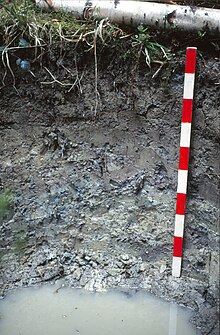Stagnosol
AStagnosolin theWorld Reference Base for Soil Resources(WRB) issoilwith strong mottling of thesoil profiledue toredox processescaused by stagnating surfacewater.

Stagnosols are periodically wet andmottledin the topsoil andsubsoil,with or withoutconcretionsand/or bleaching. The topsoil can also be completely bleached (albichorizon). A common name in many national classification systems for most Stagnosols ispseudogley.In theUSDA soil taxonomy,many of them belong to the Aqualfs, Aquults, Aquents, Aquepts and Aquolls.
They are developed in a wide variety of unconsolidated materials likeglacial till,andloamyaeolian,alluvialandcolluvialdepositsandphysically weatheredsiltstone. Stagnosols occur on flat to gently sloping land in cooltemperatetosubtropicalregions withhumidto perhumid climate conditions.
Theagriculturalsuitability of Stagnosols is limited because of theiroxygendeficiency resulting from stagnating water above a dense subsoil. Therefore, they have to be drained. However, in contrast toGleysols,drainage with channels or pipes is in many cases insufficient. It is necessary to have a higherporosityin the subsoil in order to improve thehydraulic conductivity.This may be achieved by deep loosening or deep ploughing. Drained Stagnosols can befertile soilsowing to their moderate degree of leaching.
Stagnosols cover 150–200 million ha worldwide. For the greater part in humid to perhumid temperate regions ofWestandCentral Europe,North America,southeastAustraliaandArgentina.Here Stagnosols are associated withLuvisolsas well assiltytoclayeyCambisolsandUmbrisols.They also occur in humid to perhumid subtropical regions, where they are associated withAcrisolsandPlanosols. with a light-coloured,coarse-textured,surfacehorizonthat shows signs of periodicwaterstagnation and abruptly overlies a dense, slowlypermeablesubsoil with significantly more clay than the surface horizon. In the US Soil Classification of 1938 used the name Planosols, whereas its successor, theUSDA soil taxonomy,includes most Planosols in theGreat GroupsAlbaqualfs, Albaquults and Argialbolls.
See also
[edit]References
[edit]- IUSS Working Group WRB: World Reference Base for Soil Resources, fourth edition. International Union of Soil Sciences, Vienna 2022.ISBN979-8-9862451-1-9([1]).
Further reading
[edit]- Kooijman, A.M. (2010). "Litter quality effects of beech and hornbeam on undergrowth species diversity in Luxembourg forests on limestone and decalcified marl".Journal of Vegetation Science.21(2): 248–261.doi:10.1111/j.1654-1103.2009.01138.x.ISSN1100-9233.
- Kovacevic, V.; Banaj, D.; Antunovic, M.; Bukvic, G. (2002). "Influences of genotype and soil properties on corn potassium and magnesium status".Plant Nutrition.Vol. 92. pp. 90–91.doi:10.1007/0-306-47624-X_43.ISBN978-0-7923-7105-2.
- Prietzel, Jörg; Thieme, Jürgen; Paterson, David (2010). "Phosphorus speciation of forest-soil organic surface layers using P K-edge XANES spectroscopy".Journal of Plant Nutrition and Soil Science.173(6): 805–807.doi:10.1002/jpln.201000248.ISSN1436-8730.
- Ehrmann, Otto; Puppe, Daniel; Wanner, Manfred; Kaczorek, Danuta; Sommer, Michael (2012). "Testate amoebae in 31 mature forest ecosystems – Densities and micro-distribution in soils".European Journal of Protistology.48(3): 161–168.doi:10.1016/j.ejop.2012.01.003.ISSN0932-4739.PMID22342135.
- Vieten, B.; Conen, F.; Neftel, A.; Alewell, C. (2009). "Respiration of nitrous oxide in suboxic soil".European Journal of Soil Science.60(3): 332–337.doi:10.1111/j.1365-2389.2009.01125.x.ISSN1351-0754.S2CID97292710.
- W. Zech, P. Schad, G. Hintermaier-Erhard: Soils of the World. Springer, Berlin 2022, Chapter 3.3.5.ISBN978-3-540-30460-9
External links
[edit]- profile photos (with classification)WRB homepage
- profile photos (with classification)IUSS World of Soils
